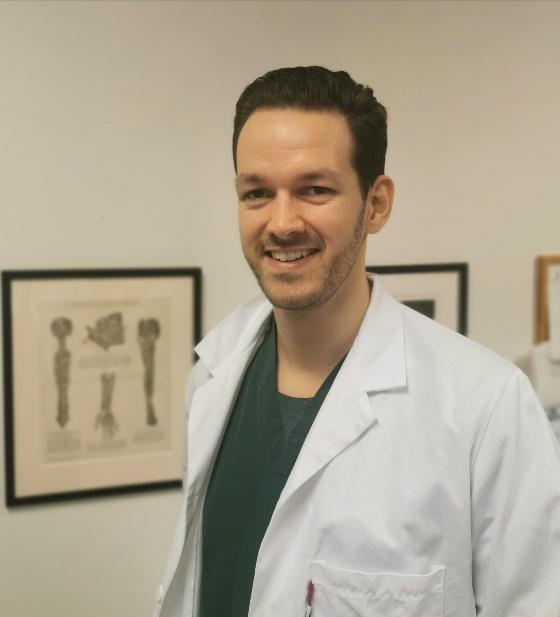Werner disputerer for ph.d.-graden i helsevitenskap og vil offentlig forsvare avhandlingen:
“Development of a prognostic model for unfavorable outcome after lumbar microdiscectomy”

Avhandlingen er tilgjengelig her! / The doctoral thesis is available here!
Disputasen og prøveforelesningen blir strømmet. The defense and the trial lecture will be streamed.
Prøveforelesning over oppgitt emne starter kl. 09.00 / The trial lecture starts at 09.00
Tittel/Title: "Patient-Reported Outcomes Measures (PROMS) in Traumatic Brain Injury Research"
Prøveforelesningen strømmes her / The trial lecture will be streamed here
Disputasen starter kl. 11.00 / The defense starts at 11.00
Disputasen strømmes her / The defense will be streamed here
De som ønsker å opponere ex auditorio kan sende e-post til leder av disputasen.
Opponents ex auditorio should sign up to leader of defense by e-mail to:
knut.fredriksen@uit.no
Populærvitenskapelig sammendrag av avhandlingen/ Summary of the thesis
Back-pain and leg-pain resulting from a disc herniation in the lower back is a widespread disease, with a heavy socioeconomic burden. Surgical treatment involves a small incision in the lower back and microscope assisted removal of the herniated material compressing the nerves. While this type of surgery is widely used, and allows for little technical variation, the outcome reported by patients is quite variable. Furthermore, while the procedure is short and carries a low complication rate, patients often report a lower functional status measured in pain and disability than after larger operations for pain-related disorders, such as total hip replacement. Thus, patient selection is an important factor if one wants to improve the quality of spine care.
In Norway nearly all public and private hospitals performing spine surgery report data to a national registry, the Norwegian Registry for Spine Surgery (NORspine). In the Norspine, both patients and treating surgeons record data regarding the intensity of pain and disability, patient characteristics such as height, weight, occupation and more, findings on medical imaging, and the surgical procedure performed. While a vast amount information is recorded this way, both in Norway and in other countries, the use of this information has had little impact on the quality of spine care thus far.
The aim of this scientific work was firstly to define a uniform outcome after surgery for a disc herniation in the lower back, which was neither judged by the patient, nor the surgeon alone. In recent years so called Patient Reported Outcome Measures (PROMs) have become a gold standard to measure a given patients ability to function as well as his/hers quality of life after surgery for pain related conditions. These measures i.e. evaluate pain and disability during different tasks in daily life on a point based score, and have proven to be more reliable in judging an outcome than simple questions regarding how a patient is feeling on a given day, or how a surgeon would rate his or hers performance. By statistical analyses of the outcome data of over ten thousand patients operated for a disc herniation in the lower back, we derived different cutoffs in these PROMs for both positive and negative outcome after surgery. We aimed at identifying those patients who would be at risk for an unfavorable outcome after surgery for disc herniation in the lower back. For this we defined two outcome categories, "failure" which implies that a patient might feel unchanged or worse 1 year after surgery, and "worsening" meaning that a patient might feel worse or even worse than ever 1 year after surgery. We found that the Oswestry Disability index (ODI), a PROM which is specific for back pain conditions, is the most suitable to define these cutoffs. Thus, we identified common point scores for patients rating their outcome as "failure" or "worsening" on the ODI. Once these cutoffs were established, for the second aim of this thesis we looked at patient data and if certain patient attributes together would be able to predict either failure or worsening as an outcome. By means of statistical analysis, we created models that would calculate a percent-based probability for each individual patient of having a surgical outcome rated as either "failure" or "worsening".
We hope that with these percentages at hand, patient and caregivers could weigh the indication versus the risk of surgery more carefully and adjust expectations prior to the procedure.
Veiledere/ Supervisors:
Hovedveileder/Main supervisor:
Førsteamanuensis Tore Solberg, Institutt for klinisk medisin,Det helsevitenskapelige fakultet, UiT Norges arktiske universitet
Biveiledere/supervisors:
Professor/Overlege Sasha Gulati, NTNU/St.Olavs hospital.
Professor Margreth Grotle, Oslo Met.
Bedømmelseskomité/Defensecomitee:
Førsteamanuensis Pravin Salunke, Ost Graduate Institue of Medical Education and Research – 1. opponent
Professor Eirik Helseth, UiO - 2. opponent
Førsteamanuensis Eva Stensland, Institutt for samfunnsmedisin, Det helsevitenskapelige fakultet, UiT Norges arktiske universitet – leder av komité
Disputasleder/ Leader of defense:
Førsteamanuensis Knut Fredriksen, Institutt for klinisk medisin, Det helsevitenskapelige fakultet, UiT Norges arktiske universitet